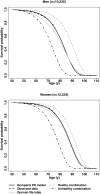Lifestyle risk factors and residual life expectancy at age 40: a German cohort study
- PMID: 24708705
- PMCID: PMC4022368
- DOI: 10.1186/1741-7015-12-59
Lifestyle risk factors and residual life expectancy at age 40: a German cohort study
Abstract
Background: Cigarette smoking, adiposity, unhealthy diet, heavy alcohol drinking and physical inactivity together are associated with about half of premature deaths in Western populations. The aim of this study was to estimate their individual and combined impacts on residual life expectancy (RLE).
Methods: Lifestyle and mortality data from the EPIC-Heidelberg cohort, comprising 22,469 German adults ≥40 years and free of diabetes, cardiovascular disease and cancer at recruitment (1994-1998), were analyzed with multivariable Gompertz proportional hazards models to predict lifetime survival probabilities given specific baseline status of lifestyle risk factors. The life table method was then used to estimate the RLEs.
Results: For 40-year-old adults, the most significant loss of RLE was associated with smoking (9.4 [95% confidence interval: 8.3, 10.6] years for male and 7.3 [6.0, 8.9] years for female heavy smokers [>10 cigarettes/day]; 5.3 [3.6, 7.1] years for men and 5.0 [3.2, 6.6] years for women smoking ≤10 cigarettes/day). Other lifestyle risk factors associated with major losses of RLE were low body mass index (BMI <22.5 kg/m(2), 3.5 [1.8, 5.1] years for men; 2.1 [0.5, 3.6] years for women), obesity (BMI ≥30, 3.1 [1.9, 4.4] years for men; 3.2 [1.8, 5.1] years for women), heavy alcohol drinking (>4 drinks/day, 3.1 [1.9, 4.0] years for men), and high processed/red meat consumption (≥120 g/day, 2.4 [1.0, 3.9] years for women). The obesity-associated loss of RLE was stronger in male never smokers, while the loss of RLE associated with low BMI was stronger in current smokers. The loss of RLE associated with low leisure time physical activity was moderate for women (1.1 [0.05, 2.1] years) and negligible for men (0.4 [-0.3, 1.2] years). The combined loss of RLE for heavy smoking, obesity, heavy alcohol drinking and high processed/red meat consumption, versus never smoking, optimal BMI (22.5 to 24.9), no/light alcohol drinking and low processed/red meat consumption, was 17.0 years for men and 13.9 years for women.
Conclusions: Promoting healthy lifestyles, particularly no cigarette smoking and maintaining healthy body weight, should be the core component of public health approaches to reducing premature deaths in Germany and similar affluent societies.
Figures

Comment in
-
[An unhealthy lifestyle costs so many years of life].MMW Fortschr Med. 2014 Oct 23;156(18):38. MMW Fortschr Med. 2014. PMID: 25464540 German. No abstract available.
Similar articles
-
Healthy lifestyle and life expectancy in people with multimorbidity in the UK Biobank: A longitudinal cohort study.PLoS Med. 2020 Sep 22;17(9):e1003332. doi: 10.1371/journal.pmed.1003332. eCollection 2020 Sep. PLoS Med. 2020. PMID: 32960883 Free PMC article.
-
Modifiable causes of premature death in middle-age in Western Europe: results from the EPIC cohort study.BMC Med. 2016 Jun 14;14:87. doi: 10.1186/s12916-016-0630-6. BMC Med. 2016. PMID: 27296932 Free PMC article.
-
Effect of major lifestyle risk factors, independent and jointly, on life expectancy with and without cardiovascular disease: results from the Consortium on Health and Ageing Network of Cohorts in Europe and the United States (CHANCES).Eur J Epidemiol. 2016 May;31(5):455-68. doi: 10.1007/s10654-015-0112-8. Epub 2016 Jan 18. Eur J Epidemiol. 2016. PMID: 26781655 Free PMC article.
-
Primary prevention of colorectal cancer.Gastroenterology. 2010 Jun;138(6):2029-2043.e10. doi: 10.1053/j.gastro.2010.01.057. Gastroenterology. 2010. PMID: 20420944 Free PMC article. Review.
-
Dose-Response Relationships between Levels of Alcohol Use and Risks of Mortality or Disease, for All People, by Age, Sex, and Specific Risk Factors.Nutrients. 2021 Jul 30;13(8):2652. doi: 10.3390/nu13082652. Nutrients. 2021. PMID: 34444809 Free PMC article. Review.
Cited by
-
Echocardiographic Assessment of Left Ventricular Function 10 Years after the Ultra-Endurance Running Event Eco-Trail de Paris® 2011.Int J Environ Res Public Health. 2022 Jul 6;19(14):8268. doi: 10.3390/ijerph19148268. Int J Environ Res Public Health. 2022. PMID: 35886119 Free PMC article. Clinical Trial.
-
Moderate alcohol consumption is associated with lower chronic disease burden expressed in disability-adjusted life years: a prospective cohort study.Eur J Epidemiol. 2017 Apr;32(4):317-326. doi: 10.1007/s10654-017-0247-x. Epub 2017 Apr 13. Eur J Epidemiol. 2017. PMID: 28409278 Free PMC article.
-
Factors involved in human healthy aging: insights from longevity individuals.Front Med. 2025 Apr;19(2):226-249. doi: 10.1007/s11684-024-1120-4. Epub 2025 Mar 22. Front Med. 2025. PMID: 40119024 Review.
-
Associations between Liver Enzymes, Lifestyle Risk Factors and Pre-Existing Medical Conditions in a Population-Based Cross-Sectional Sample.J Clin Med. 2023 Jun 26;12(13):4276. doi: 10.3390/jcm12134276. J Clin Med. 2023. PMID: 37445311 Free PMC article.
-
Association of healthy lifestyle score with all-cause mortality and life expectancy: a city-wide prospective cohort study of cancer survivors.BMC Med. 2021 Jul 7;19(1):158. doi: 10.1186/s12916-021-02024-2. BMC Med. 2021. PMID: 34229666 Free PMC article.
References
-
- Katanoda K, Marugame T, Saika K, Satoh H, Tajima K, Suzuki T, Tamakoshi A, Tsugane S, Sobue T. Population attributable fraction of mortality associated with tobacco smoking in Japan: a pooled analysis of three large-scale cohort studies. J Epidemiol. 2008;18:251–264. doi: 10.2188/jea.JE2007429. - DOI - PMC - PubMed
-
- Kant AK, Graubard BI, Schatzkin A. Dietary patterns predict mortality in a national cohort: the national health interview surveys, 1987 and 1992. J Nutr. 2004;134:1793–1799. - PubMed
Publication types
MeSH terms
LinkOut - more resources
Full Text Sources
Other Literature Sources

